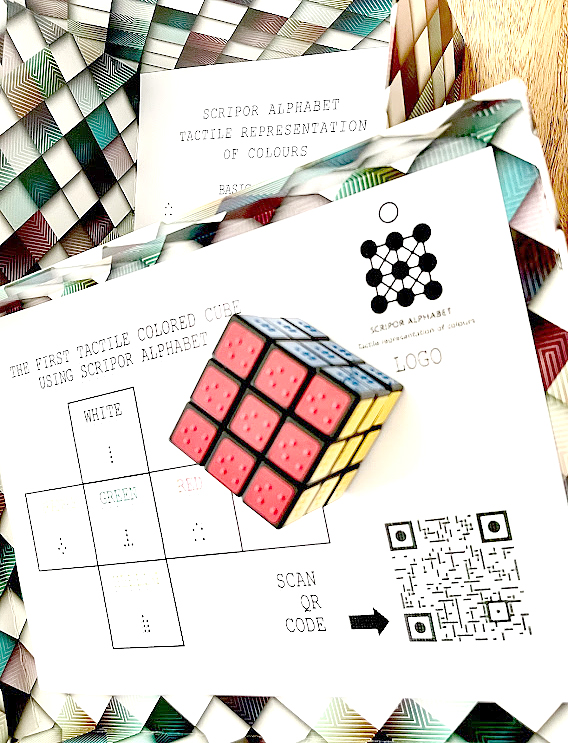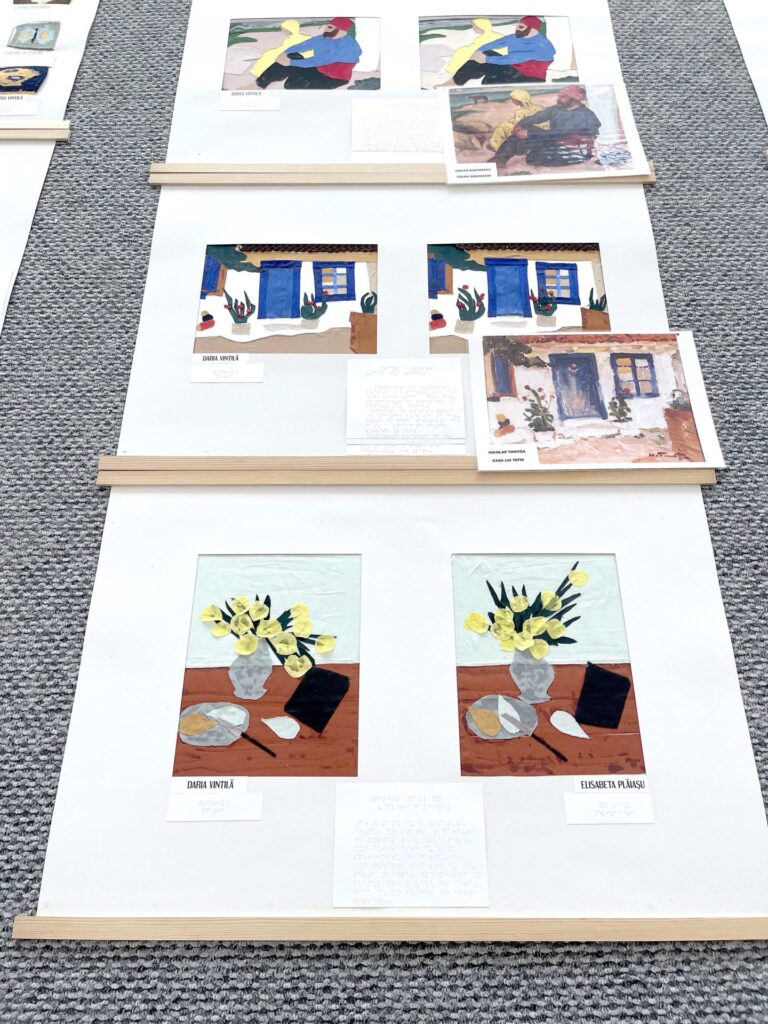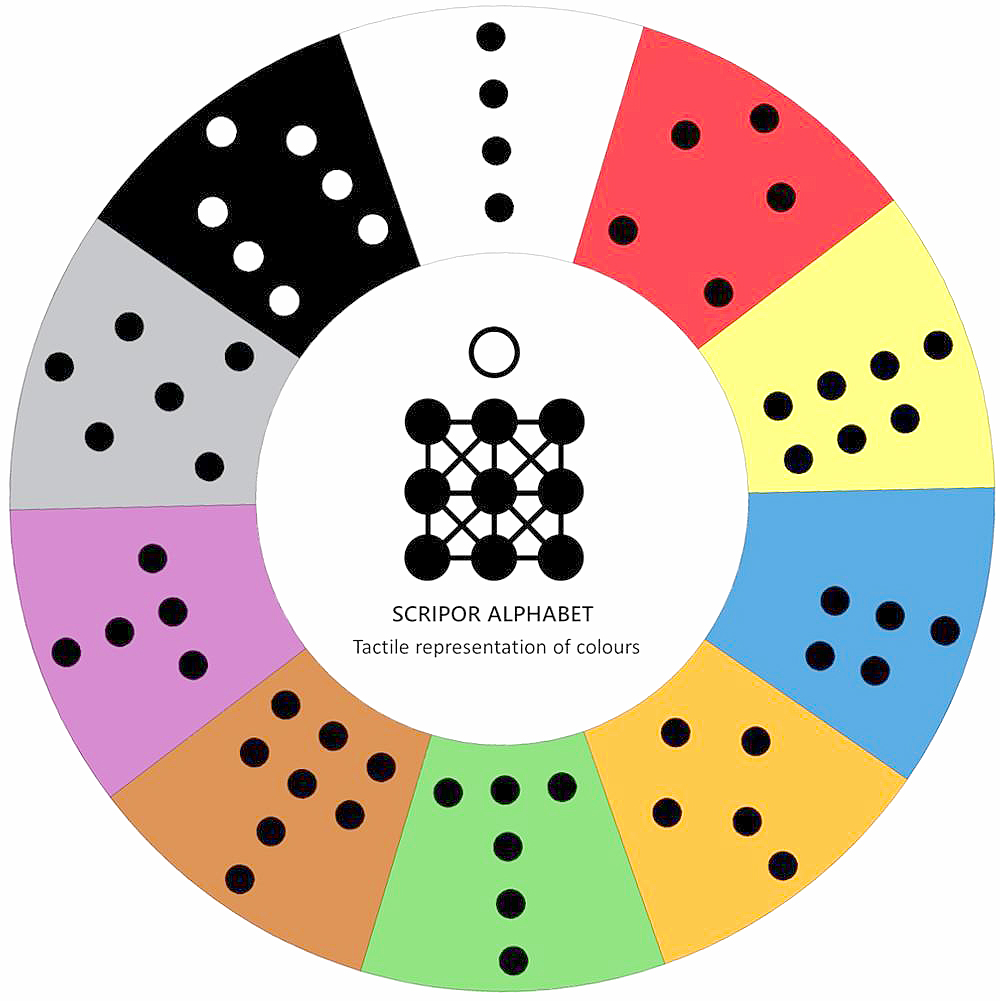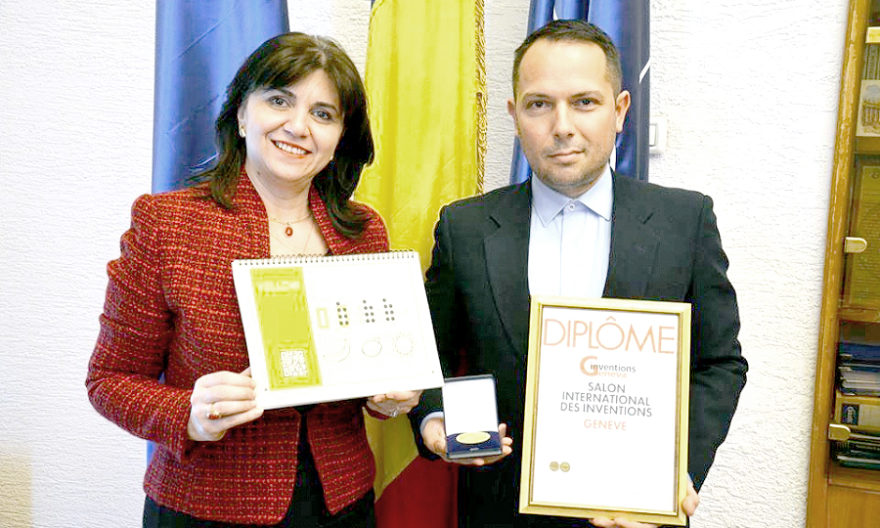The tactile alphabet of colors, an extension of the Braille alphabet that eliminates the chromatic barriers between the visually impaired and the normal world
One of the first things a child learns about the external world is related to the concept of color. It is a concept accessible from an early age and a primary way of structuring the immediate environment. Over time, color has become an easy means of conveying information, building an entire symbolism around colors from a cultural perspective. There are areas of daily life where we can talk about a standardized and universal conventional use of colors, especially regarding traffic signs, signaling dangerous situations, branding, logos, etc. A world where information reaches people through these means. However, this is not the case for people with visual disabilities.
The tactile alphabet of colors, known as the Scripor alphabet, was named after its creator, Tudor Paul Scripor. It is a concept based on complementing the Braille alphabet and is used solely for colors. This innovative chromatic standardization, which is easy to learn and universal, allows individuals with visual disabilities (blindness, amblyopia, achromatopsia/color blindness) to tactically identify, write, read, recognize, and differentiate colors. It is, therefore, a specially designed tool to meet the needs of visually impaired individuals, offering them equal opportunities. Making the social environment accessible through the Scripor alphabet, provides people with visual disabilities the possibility to live fully and inclusively in a world where the use of colors in various fields is widespread.
The word “color,” regardless of language, dialect, culture, or geographical area, has thus been reduced to a unique, simple, and universal symbol. Color is represented by a combination of dots, positioned in a cell similar to the Braille alphabet. – Anca Corcheș, psychopedagogical teacher at the Special School for the Visually Impaired in Cluj-Napoca.
By using the Scripor cell to represent colors, the visually impaired and color-blind individuals can easily distinguish colors, shades, and even their intensity, improving their everyday lives. By using tactile color labels, visually impaired athletes can choose their own martial arts belts and recognize flags and medals. Visually impaired or visually disabled individuals can choose healthy/ecological foods for themselves, for example, using color-based codes such as Nutri-Score, and can purchase their preferred products based solely on color. They can buy clothing and cosmetic products, board games, toys, thus becoming more independent and confident. Additionally, the tactile alphabet of colors offers new opportunities in creating new jobs involving color-based sorting, inclusive education, assistive technologies, entertainment, and much more, thus providing professional inclusion.

The inventor of the tactile alphabet of colors, Tudor Paul Scripor, and one of his close collaborators, architect Sanda Oltean, Inclusive Design & Accessibility Consultant within the Association and former chief architect of Cluj County, spoke to the newspaper Făclia about the amazing discovery and the enormous potential for global application that this alphabet has in almost any field of activity on this planet.
Reporter: Is Cluj a friendly city for visually impaired individuals?
Tudor Paul Scripor: At the moment, Cluj is the most accessible city in Romania from this point of view, but it’s not entirely so. But out of the little that was accomplished in Romania, Cluj stands the best.
And compared to the European space?
Tudor Paul Scripor: We are decades behind.
What specific problems do these people face?
Sanda Oltean: There is legislation in place, and we also have those ramps at the entrance of public institutions, but it exists at the level of regulations and not necessarily physically.
Tudor Paul Scripor: The legislation is not enforced, those who violate the law are not punished.
Sanda Oltean: It’s like the eternal problem of traffic. When a city was designed for carriages and now we have four cars for a three-room apartment, and we all go to the city center by car, it’s the same with buildings. They are old buildings that are not necessarily suitable for modification. Whether it’s from the perspective of the Historical Monuments authorities, you can’t make aggressive changes and add ramps, in other words, you can’t easily adapt them. The problem should be addressed with new buildings.
How did you come up with the idea for this revolutionary alphabet?
Tudor Paul Scripor: The tactile alphabet of colors is a complement to the Braille alphabet. For the visually impaired, Braille represents numbers and letters, and it is used for reading and writing. It also includes musical notes and mathematical signs, but it does not include colors at all. To express a color, such as blue for example, you would have to write the word letter by letter. It is irrelevant for a visually impaired person from Hungary, for example, to understand the Braille alphabet in Romanian and vice versa. However, since color is a universal term, we have reduced it to a single universal symbol. It is, therefore, a combination of dots like in the Braille alphabet. This symbol is easily recognizable for both a Romanian and a person from another country.
Sanda Oltean: Now, even the concept of color, 80 percent of the visually impaired have a notion of color and space if they have lost their sight during their lifetime.
Tudor Paul Scripor: For those who have never seen, and here we are talking about up to 20 percent of the blind population, the concept of color doesn’t exist. And this alphabet is actually a standardization or, better said, a convention. They are not interested in knowing, literally, what red or green looks like. They are interested in knowing whether this shirt, for example, is white or green or red. And now, thanks to this alphabet, they can make that distinction and identify the color.
It all started in 2012. I was conducting a painting workshop, teaching painting techniques and restoration, and a visually impaired student enrolled in my workshop. I explained to him as best as I could what a painting looks like, but I explained it from a volumetric perspective. For example, it was Grigorescu’s painting “Shepherd with Sheep,” and I recreated a sheep using cotton, and its legs with matchsticks. But he reproached me, saying that I shouldn’t have taught him that, but rather the color itself. At that moment, I didn’t know that there wasn’t an international convention for color recognition for the visually impaired. I was very surprised to discover that such a convention didn’t exist, and from 2012 until 2019, I worked on developing this alphabet.
Many who attempted to create this color alphabet before me chose the wrong path, in my opinion. They opted for various textures, irrelevant to the blind, or geometric shapes. The blind develop conventions within their own families, but those are only valid within those contexts.
So, I chose to move towards literacy, towards the language they already use. I expanded the Braille cell from its current six dots to nine, plus an orientation dot. This orientation dot is omnipresent in every cell because it shows the position. To give you an idea, it’s like the north on a compass or the number 12 on a clock.
I patented this alphabet in December 2018, and the following year, I considered it appropriate to present it to the public because it offered us protection in this regard. And the best place to present an invention is, clearly, the Salon of Inventions and Innovations in Geneva. We registered there, and we were accepted. We were pleasantly surprised to find out that the salon was not just an ordinary fair where you present your invention and that’s it; it’s an inventors’ Olympiad. We received the “Grand Prize of the German Inventors Association,” an award rarely given and only awarded to inventions with a significant impact on society, and the gold medal in the “Art-Culture-Education” category.
Sanda Oltean: Regarding the applicability of this invention, one example is clothing labeling. Visually impaired individuals seek independence the most, and it becomes very easy to identify, for instance, on a label, that it’s a black blouse with red flowers. They have the freedom to decide what to buy and what to wear.
Tudor Paul Scripor: We have a gentleman in our association who is passionate about electrical engineering and amateur radio. Initially, he didn’t necessarily oppose or pay attention to this invention, thinking that a color alphabet is useless to him since he can’t see colors anyway. However, he had various projects he wanted to work on and surprisingly encountered difficulties precisely when it came to colors in terms of electrical circuits, cables, and the required parts for his projects. Eventually, he contacted us to learn more about this alphabet and adopted it immediately.

Then, this spring, I gifted a family with labels for Easter eggs. After the holidays, I received a very emotional phone call from people who have never seen colors, thanking me because, for the first time in their lives, they had a wonderful holiday experience, as they always knew the color of each individual egg.
This alphabet brings with it all kinds of world premieres in terms of its utility. People come to us with various solutions where they identify that this alphabet is useful.
Sanda Oltean: Here, I want to share another premiere. We have visually impaired individuals who have managed to solve the Rubik’s Cube! They can solve and play almost all the childhood games. Furthermore, we organized an exhibition where the tactile alphabet was explained to them, and they were given a painting as a model. They were able to reproduce it without actually seeing it, solely based on tactile perception. The paintings are nearly identical, it’s fabulous! But we also reached the accessibility in architecture aspect. It’s something similar to subway maps, we all know how they look. That’s how we created the map of the Cultural Center in Marghita. Basically, based on a tactile map placed at the entrance, which reproduces the circuits, the foyer, the restroom, or the wardrobe, they can perceive the space and navigate the entire room on their own.
Similarly, with the Cluj-Napoca City Hall, we have created, based on a protocol, a tactical circuit from the entrance gate, so that visually impaired individuals can navigate independently, without any external assistance, directly to the counter where they need to address an issue.We have discussions with Mr. Șerban Țigănaș, the Dean of the Faculty of Architecture, for a course support regarding volunteering, to involve students who do not have visual impairments in the accessibility aspect and organize joint workshops. It would also help us, those who can see, to perceive 3D spaces differently, for example, spaces that visually impaired individuals perceive completely differently than us. We are talking about the layout of a hospital, a church, a public institution, or a theater. All these places have predefined spaces, and with their help, it’s very easy to create a 3D guide.
I believe that this project can expand to the streets as well. For example, by touching a panel on a building, the visually impaired can get an idea of its architecture, including its colors…
Tudor Paul Scripor: In Cluj, we have the five tourist routes: Renaissance, Gothic, Baroque, and so on. I proposed that all these five routes be represented on the same tactile map because the city center is the same, but with different colors depending on each specific tourist route. And what is very important, because we were talking about the universality of this alphabet in the beginning, is that even a visually impaired German tourist or a Hungarian one who visits the center of Cluj can now easily identify points of interest. And, of course, this can also help a normally sighted person with orientation.
This tactile alphabet of colors is taught, and that has led to an opportunity for blind children to learn colors before numbers and letters, just like sighted children do. Previously, blind children would start learning the Braille alphabet in kindergarten or first grade. However, now we have reached the point where the color alphabet prepares the child for the Braille alphabet, and this is extremely important.
In this regard, we already have a protocol signed with the Ministry of Education since February 2020. The following month, we were supposed to implement this project in the first school for the blind in Romania, but the pandemic stopped us. Consequently, I have taught this alphabet to many visually impaired individuals from around the world through online systems. Then I realized the great opportunity that this pandemic has offered us, namely to scale this alphabet internationally by creating a global educational platform. Children from the Association ask us how animals look, how flowers look, how food looks. Additionally, we are on the verge of finalizing a collaboration with a famous beverage company to apply the code of that specific beverage on its label, which will aid in quickly identifying the exact drink. We have already conducted an experiment in this regard by labeling different varieties of the beverage with different colors, and the blind boy went straight to the desired drink and put it in the basket. The experiment continued at his home, where he placed the drinks in the refrigerator and, for the first time, he was able to ask those around him what they would like to drink! Stefan, that’s his name, was extremely happy and burst into tears of joy in the following moment, amazed that he could solve something so trivial for the rest of us!
Furthermore, we are in discussions to create restaurant menus accessible with the help of this alphabet. Visually impaired individuals don’t know how a cake or a chocolate looks like, for example. With this alphabet, we have solved that problem practically. This is a project that can be expanded wherever you want, in clothing, identifying medications, choosing colors to paint your home, or withdrawing money from ATMs. For instance, a famous blind Indian chef contacted me and confessed that thanks to this alphabet, he can efficiently code his spices. It is astonishing how many areas this alphabet can be applied to.

This alphabet brings people together at the same table, effectively uniting entire communities. That’s what fascinates us. The implementation of the alphabet has reached an international level. We have partnerships in 23 countries, in addition to European Union countries, including the United States, Canada, Australia, and so on. The invention is relatively new, and now the world is becoming aware of and recognizing the vast range of applications for this alphabet. Interestingly, the utility of this alphabet is better known outside the country. We even joked with my colleagues that if we were born in another country, like America, for example, this alphabet would already be widely used on a global scale, and maybe we would already be millionaires.
How do you protect your invention?
Tudor Paul Scripor: Very simply and effectively: through patents and registered trademarks.
How many people are involved in this project?
Tudor Paul Scripor: There is a core team of up to a few dozen people, but when it comes to volunteer members from other countries, we’re talking about hundreds, if not thousands, of visually impaired and sighted individuals from all fields of activity, all willing to help with the implementation of this project.
What’s next? What is the next step you have in mind?
Tudor Paul Scripor: The next step is to gather companies around us that will pioneer the accessibility and introduction of this alphabet wherever it is needed.
Recognitions and Confirmations of the Scripor Alphabet:
- Tudor Paul Scripor – Global Outstanding Leadership Award, Education 2.0 Conference, Dubai, March 2022.
- Scripor Alphabet Association – Organization of the Year, WORLD IDOL 2021, Chance For The Blind Foundation, Poland, September 2021.
- Product of the Year 2021, Scripor Alphabet – Manual for Learning the Tactile Alphabet of Colors, Chance For The Blind Foundation, Poland, September 2021.
- Gold Medal and Special Award, Hungarian Inventors Association, ÖTLET CLUB 13 Egyesület, Hungary, June 2019.
- Gold Medal and Special Award, Banat Inventors Society, June 2019.
- Grand Prize awarded by the German Inventors Association, 2019, Scripor Alphabet SRL, International Exhibition of Inventions and Innovations in Geneva, April 2019.
- GOLD Medal, Scripor Alphabet SRL, International Exhibition of Inventions and Innovations in Geneva, April 2019.
Florian Ionascu, visually impaired student: “Knowing and interpreting colors seems like something from the realm of science fiction.”
“I have heard about this alphabet of colors, but I was not convinced of its effectiveness until recently. I would like to learn it. This invention is another significant step towards accessibility and inclusion in my opinion because it means more information about what surrounds us and the disappearance of this significant barrier of colors, which, in my view, will lead to a much better integration into society than we have now. The fact that the barrier has disappeared makes me think of the fall of the Berlin Wall and the Schengen Area because this invention is reducing the borders between our world and that of sighted people, making them fewer and easier to cross. Knowing and interpreting colors as a visually impaired person seems to belong to science fiction, but the reality is quite different. Tudor Scripor, this Louis Braille of Romanians, has demonstrated it, and his effort deserves to be appreciated by everyone.”
Sandu Mureșan

